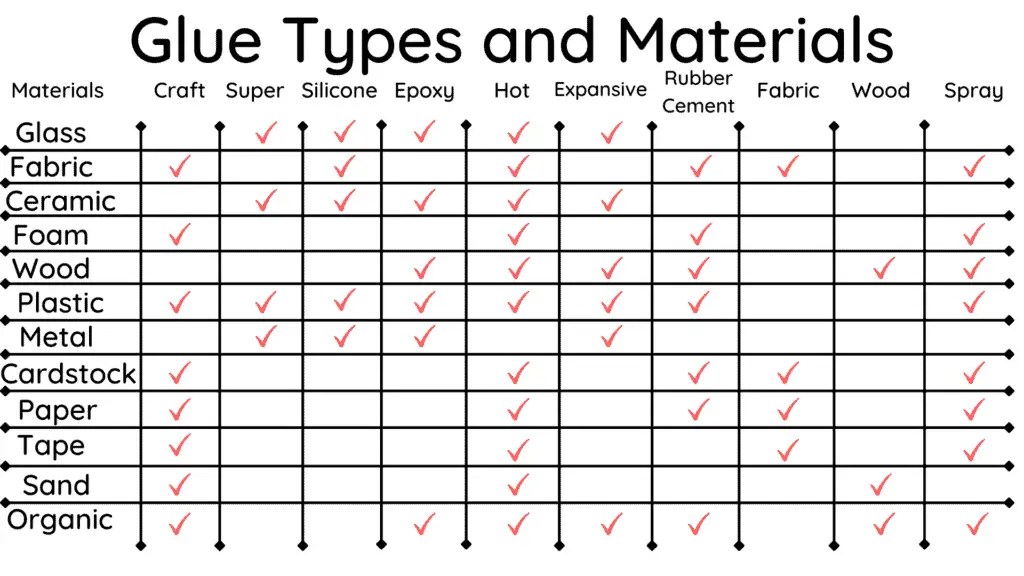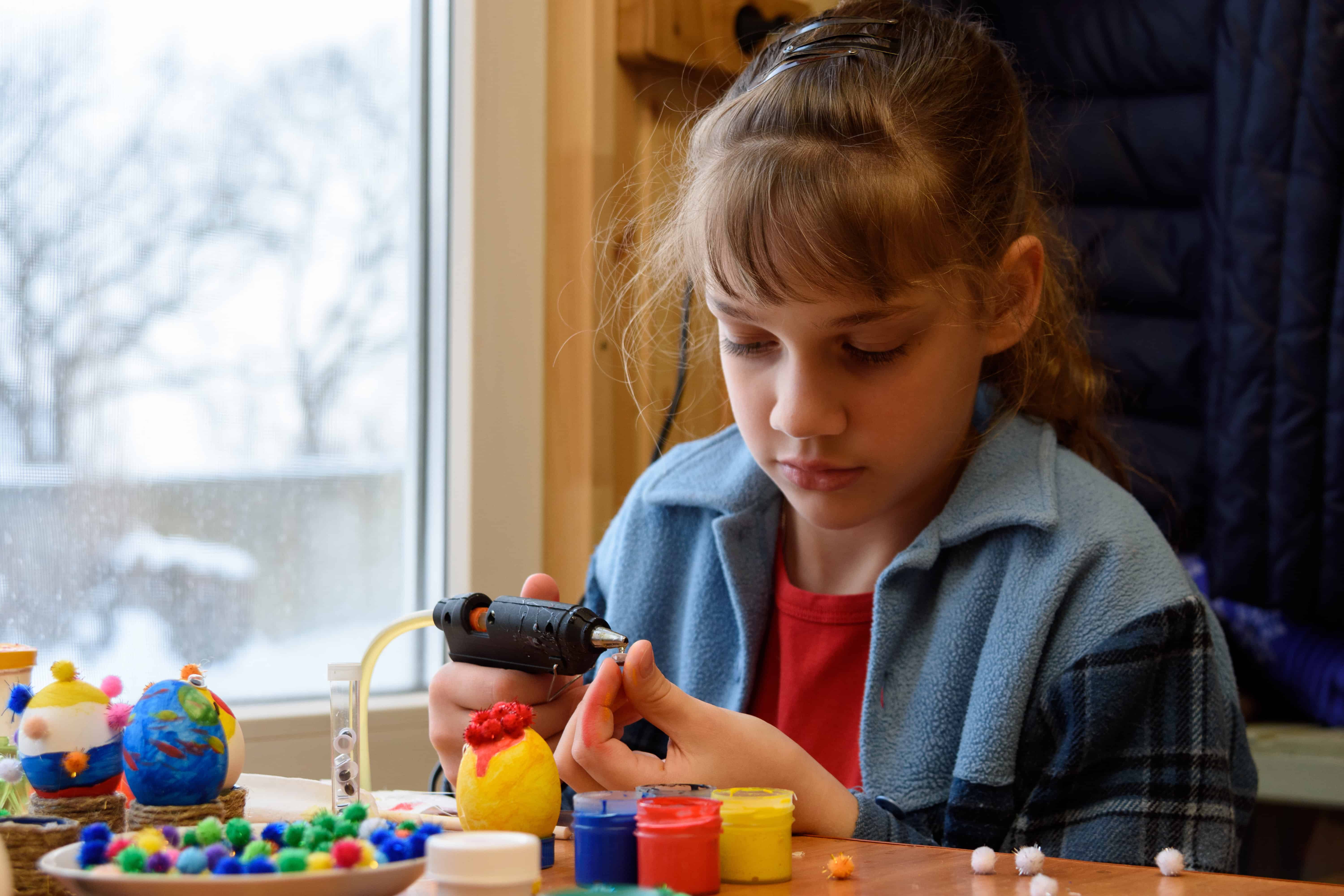Many kinds of glue are useful for at-home projects with kiddos and are sturdy enough to maintain your projects. I have purchased glue varieties and found them a go-to item for our 3-dimensional ideas, home repairs, and multi-sensory projects. Glue has been therapeutic throughout the years and has served us well throughout our tiny artist’s endeavors.
Please remember to use your discretion and identify glues that suit you and your family’s needs. There are glues for different purposes, and each has unique characteristics and ingredients.
10+ Different Types of Glue
- Craft Glue
- Super Glue
- Silicone Glue
- Epoxy Glue
- Hot Glue
- Expansive Foam Glue
- Rubber Cement Glue
- Fabric Glue
- Wood Glue
- Spray Adhesive
Glue is a type of sticky adhesive used to make things stick together. It is a staple in my art room and very useful for all kinds of projects and activities– big or small.
This post will explain a bit of glue history. Be sure to continue reading about glue types, their purpose, and some safety measures you should take when starting a task. There are also more articles on age-appropriate glue activities for young children if you are looking for project ideas or want to see glues for this specific age range.

This post may contain affiliate links.
Glue History
According to ScienceABC, glue was found in caves in France by archaic humans –neanderthals. They wanted to preserve artworks. Mixing paint with glue made their art resistant to elements and moisture within the cave. Eventually, chemical manufacturing companies created different plastics and materials that replaced older glue versions to create more common forms of glue and adhesives.
The best route to preparing for your project is to understand which glue serves what material and whether it is the best. If it is a younger child, assess their age and ability to follow instructions before committing to a specific task.
Decide whether this is for an item they want to create or a sensory experience. It could be a combination of both. Try to lean into the best choice for your child’s interest, so you are prepared to help with the task if it involves multiple steps, or allow space if they use glue as a unique hands-on tool. I have created a chart of the glues best suited for specific materials and a chart of the glues best suited for sensory games.
1. Craft Glue

Crafting glue is for essential arts and crafts and paper projects. Craft glues are typically white, clear, or glitter pastes and are helpful for most materials, child’s crafts, or do-it-yourself activities. They can be in liquid or stick forms in easy-to-apply packaging.
Different surface areas for the applicators range from tiny to thick for optimal application. They are non-toxic, quick-drying, and easy to wash—a definite go-to for younger children.
2. Super Glue

Super glue is a clear, powerful, quick-drying adhesive. Its use is for many at-home projects or repairs– ceramic, glass, plastic, and metal. The packing is typically small pouches or plastic squeeze bottles with long plastic tips for easy application.
Since super glue can be semi-permanent in specific applications, it’s best to use adult supervision. It is not considered toxic; however, its strong bond is problematic once dried. It is not for ingestion and should be watched by an adult if kids can read and follow instructions.
3. Silicone Glue

Adhesives and sealant glues are for home repairs like filling holes, small cracks, and breaks on materials like glass, metal, and plastic. They are water-resistant, strong but flexible, and relatively quick-drying. This glue has –or should have– a brush applicator for materials.
Silicone glue is non-toxic and should be used with caution. If you consider it for a child’s activity or repair, please have an adult present to monitor the application. This glue should be applied by adults or with supervision for children reading and following instructions.
4. Epoxy Glue

Epoxy glue is strong, durable, and water-resistant. It is best for metal, glass, wood, and ceramic materials. Most commonly used for household projects, epoxy glue begins drying reasonably quickly and doesn’t need pressure for more than 5 minutes to start its curing process. Applicators are usually narrow, gun-like objects or tubes that dispense the glue.
Whether or not it’s considered toxic seems debatable. According to the CDC, epoxy glue in specific work environments poses risks to an individual’s health. It is best not to inhale epoxy glue as the fumes cause concern for the respiratory system. Before handling or manipulating epoxy glue, please use gloves, safety goggles, and proper ventilation. Adults should apply this glue for children’s repairs or monitor structured activities.
5. Hot Glue

Hot glue is a reliable crafting glue and is helpful with any material. It is very affordable, safe for young children, and is considered non-toxic.
Be sure to purchase a mini glue gun (found on Amazon), so the temperature does not get high enough to burn tiny fingers. It is made to be in a stick form and melts in the glue gun for easy application. This glue dries almost instantly. Hot glue is an excellent option for young children.

6. Expansive Foam Glue

Foam filler fills small areas vulnerable to the elements or areas that need extra protection– glass, wood, metal, and plastic. Expansive glue quickly grows during application to ensure the surface area of the material is completely covered. The cans have a narrow hose or applicator to move the expanding glue to its desired location.
Users should shake the cans vigorously to mix chemicals before application. This spray glue is used mainly for home repairs (filling holes), but I have seen it used for crafting purposes. It can be dried, cut, sanded, or painted. Once dried, the foam’s active ingredients become inactive, causing no harm.
Its toxicity levels depend on the foam’s physical nature– wet versus dried.
I recommend waiting until the foam is completely dry before handling it with bare hands or painting. Before application, safety measures should be in place; gloves, ventilation, and goggles—adult application required for children’s activities, repairs, and projects.
7. Rubber Cement Glue

Rubber glue is a quick-drying flexible adhesive used for projects and crafts –fabric, wood, plastic, and paper– and can serve many different purposes.
Its objective is to dry, hence drying adhesive, onto the material before applying additional pressure. It is best used with a brush, then dried before adhering to surfaces; it is very sticky.
Rubber cement glue is highly flammable and recommended for older kids with adult supervision. This glue should be applied by an adult and with care if needed for younger children’s projects or repairs.
8. Fabric Glue

Semi-permanent, flexible, waterproof glues used to connect fabric and paper materials are called fabric glue. They are useful for hemming, creating, and modifying clothing, bags, felts, and other fabrics.
This type of glue is non-toxic and dries clear (although it may take time), but should be used with adult supervision if your child is not reading or following label directions. The glue applicator has an easy-to-use, narrow tube and can be used for thick cards, strong tapes, and thick papers if desired.
9. Wood Glue

Wood glues tighten the bond between pieces of wood, foam, and other natural materials. Different types strengthen the materials to be stronger than their natural state.
Projects include woodworking, crafting, cabinetry, and DIY projects. Wood glue is not harmful but should be used cautiously and proper safety materials when handling the bottle– like gloves.
Some do contain toxic compounds when wet that become inactive once dried. An adult should use wood glue with an older child for a project or repair.
10. Spray Adhesive

Spray glues are used by dispensing a light mist onto projects to adhere materials together. It is for fabric, foam, wood, and paper for repairs, crafts, and home projects.
This bonding spray is quick-drying, easy to use, and strong. Spray glues are safe for at-home use but should be with proper ventilation, gloves, and goggles.
Spray adhesives should be used by an adult or with supervision if a young adult or child understands and follows label instructions.
